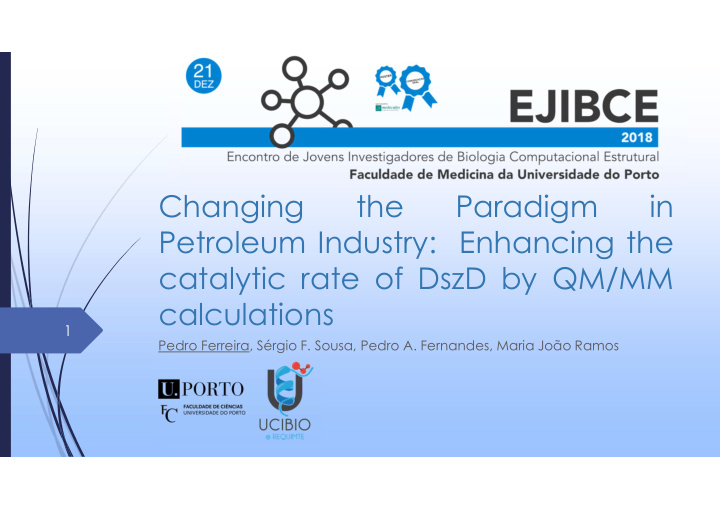



Changing the Paradigm in Petroleum Industry: Enhancing the catalytic rate of DszD by QM/MM calculations 1 Pedro Ferreira, Sérgio F. Sousa, Pedro A. Fernandes, Maria João Ramos
2 1. Background
1. Background 3 The problem: Sulfur compounds are present in crude oil in concentrations between 0.1 and 8% (w/w). Legal restrictions in increasingly more nations regarding the sulfur content in fossil fuels. The main method to desulfurize crude oil is the energetically expensive chemical hydrodesulfurization (HDS). High temperature and high pressure Fig 1. Chemical structure of dibenzothiophene (DBT)
1. Background 4 The alternative: Biocatalytic desulfurization (BDS) Explores the process “4S pathway” of Rhodococcus erythropolis Uses DBT as a source of sulfur Maintains the energetic value of the oil Much cheaper than HDS Does not produce undesirable by products PROBLEM: Catalytic rate not attractive for industrial application
1. Background 5 4S pathway Desulfurization of DBT to 2’-hydroxybiphenyl Carried out by four enzymes of Rhodococcus erythropolis : DszA DszB DszC DszD
1. Background 6 DszD Responsible for supplying FMNH 2 in the 4S pathway Overexpression of DszD improves the catalytic rate of the whole pathway Experimental studies revealed the importance of Thr 62 Mutation of Thr62 by Asn and Thr improved the catalytic rate
1. Background 7 DszD Sérgio F. Sousa et al. The Journal of Physical Chemistry A 2016 120 (27), 5300-5306
1. Background 8 DszD Sérgio F. Sousa et al. The Journal of Physical Chemistry A 2016 120 (27), 5300-5306
1. Background 9 Goal Attempt to find ways to accelerate the limiting step of the DszD reaction using hybrid quantum mechanics/molecular mechanics (QM/MM) methods, by systematic mutation of Thr62 for 18 different amino acid residues.
10 2. Methods
2. Methods 11 •Mutation of the participating residue by all amino acids •Using pymol mutation feature • Dunbrack rotamer library of rotamers Mutations •Minimization of the mutated residue Minimization •Optimization of the reactants •Linear transit scan of the rate limiting step •Characterization of the transition state •Intrinsic reaction coordinate (IRC) calculations to find the mínima ONIOM •Final energies at B3LYP-D3/6–311++G(2d,2p):FF99SB//B3LYP/6–31G(d):FF99SB
2. Methods 12 44 atoms in the mutant with Gly to 61 with Trp
13 3. Results
3. Results 14 The results confirm the potential that the reaction rate of DszD has to be enhanced through A direct correlation between the “type” of the residue and the activation free energy of the reaction cannot be drawn
3. Results 15 Structural analysis Negative charge may stabilize NAD + Hydrogen bonding system between water, ASP and NAD + is unique GLU is farther from NADH than ASP which may explain the higher activation barrier
3. Results 16 Structural analysis Side chains stay far from the • reaction coordinate Conformation of the side chains • seem to lock NADH in place. Hydrogen bond NH—N5 in the • variant with TYR is the weakest of all variants less stabilization of the reactants structure reactants and TS energetically closer
3. Results 17 Structural analysis Short or no side chains like those of VAL, ALA and GLY seem to let NADH misalign with respect to FMN Polar groups directly pointing to the reaction coordinate, may impair the free flow of the electron to be transferred
3. Results 18 Structural analysis Misalignment of NADH towards FMN in the variant with CYS Hydrogen bond between the NH res33 – N5 FMN weakens more from R TS with CYS (2.55 Å –> 2.74 Å) than with SER (2.43 Å –> 2.54 Å) Hydrogen bond OH Ser – N5 FMN is stronger in the TS than in the reactants
3. Results 19 Structural analysis Positive charge of these residues are pointing to NADH which is oxidized to NAD+ with the loss of the hydride Very bulky residues
3. Results 20 Structural analysis
21 4. Conclusions
4. Conclusions 22 The spectator residue seems to slow down the reaction The catalytic rate of DszD can be greatly enhanced through point mutations of the spectator residue Enhancement of the other enzymes of the 4S pathway is mandatory to make the 4S pathway industrially attractive comparatively to the chemical processes currently used.
5. Acknowledgements 23
Recommend
More recommend